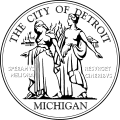 | |
| Use | Civil flag |
|---|---|
| Proportion | 3:5 |
| Adopted | 1948 (last modified in 2000) |
| Design | City seal emblazoned on quartered background. |
| Designed by | David E. Heineman [1] |
The flag of Detroit was designed in 1907 by David E. Heineman and was officially adopted as the city's flag in 1948. Its design has been slightly altered several times in the years since, the most recent in 2000.



